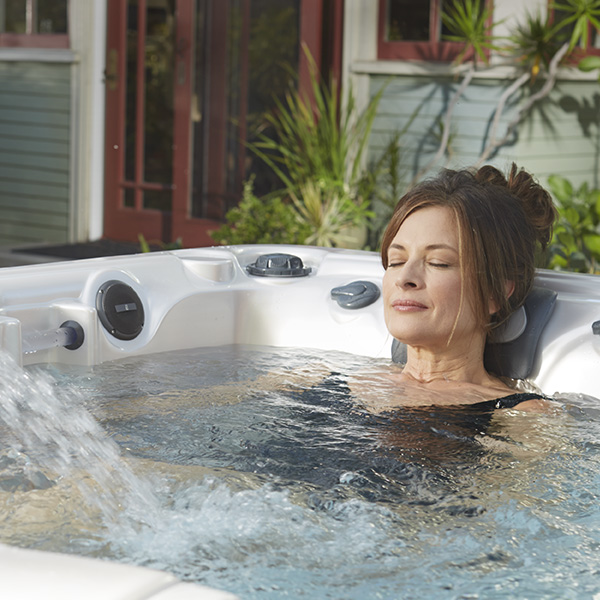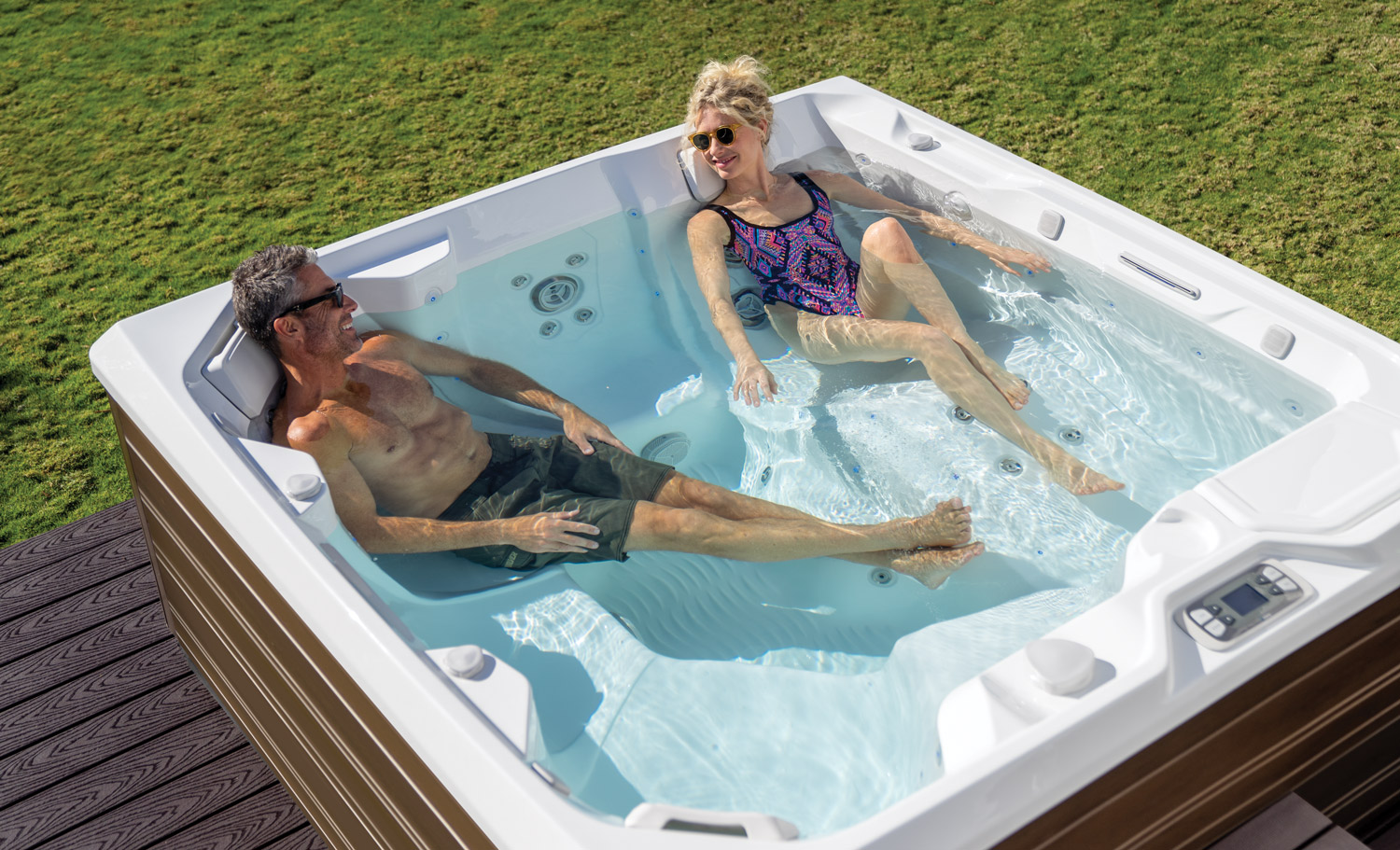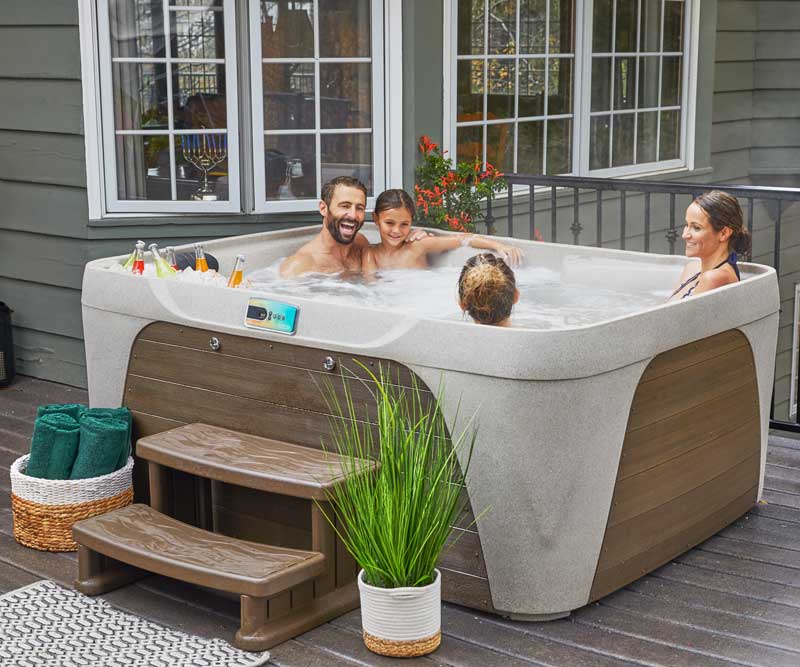Snake River Pool & Spa
- CONTACT US:
- Boise
- |
- Meridian
- |
- Nampa
- |
- Twin Falls
- (208) 468-8827
How To Keep Hot Tub Water Clean
How to Keep Your Hot Tub Water Clean
A Comprehensive Guide to Quality Hot Tub Maintenance
Splash! Spray! Spritz! Ah, water. Humans are composed of approximately 60% water and we need it to stay alive. The average hot tub is filled with 200 – 700 gallons of water and it needs to be clean, clear and sparkling to provide life-giving benefits. Creating and maintaining healthy water balance and chemistry is attainable once you know the essentials.
It is vital to know the best water care options for your hot tub. Educating yourself is the key to develop a cache of tools that alleviate any water related challenges. You will build confidence in your routine as you achieve and maintain proper water chemistry. Keeping your hot tub ready to serve you and your family is the goal. Sparkling, clean, clear water will propel you past the goal line. Let’s plunge into the knowledge.
Find a hot tub water care routine that works for you
It is easy to be drawn into the idea that your hot tub water needs to be perfect. Well, there’s a reason why all the measuring devices include a range of acceptability. There are many things that affect the quality of your hot tub water including but not limited to heat, sun, chemicals and how many people use the hot tub (aka bather load). Rest assured variations are guaranteed and adjustments are always within reach. Use your favorite method to determine the healthy ranges for your water, and then relax. Your confidence will build as you develop a routine that works for you.
Best Hot Spring Spas Hot Tub
Water Treatment Options
It is important to learn about products that help you create the optimal hot tub water treatment experience for you, your family and friends. The following are a few essential items that will make your life easier and your hot tub water clean, clear and sparkling;

FROG® @easeTM In-Line System with SmartChlor® Technology
- Pre-filled mineral and chlorine cartridges eliminate the guesswork and provide carefree sanitation.
- In-line cartridges are smart and convenient. They fit inside your filtration system and automatically maintain consistent levels of sanitization.
FROG® @easeTM In-Line System with SmartChlor® Technology
- Pre-filled mineral and chlorine cartridges eliminate the guesswork and provide carefree sanitation.
- In-line cartridges are smart and convenient. They fit inside your filtration system and automatically maintain consistent levels of sanitization.
FROG @ease Floating System
- FROG @ease combines our sanitizing minerals with SmartChlor® Technology to kill bacteria two ways. The result is Fresh Mineral Water® that’s silky soft with far less odors and the easiest water to maintain because it’s self-regulating. It knows when more sanitizing power is needed and automatically delivers it. When you need to do something, it flips over.
pH Up and pH Down. The pH balance of a liquid refers to the acid / alkaline balance. The pH scale runs from 1 to 14, with 7.0 being neutral. Any measure below 7.0 is considered acidic, which can cause deterioration of the fittings and surfaces of your hot tub. Any measure above 7.0 is considered alkaline. The optimal pH for hot tub water is 7.4, which happens to be the same pH level as the human eye.
Defoamer. A defoamer eliminates foaming caused by soap, shampoo, cleaners and other residues. While it is recommended that you shower before going in a hot tub, it isn’t always practiced. It can also be used to manage foam caused by soft water.
Conditioners and stabilizers. Water harshness can be lessened by using water conditioners. For example, use Vanishing Act which removes calcium buildup for softer-feeling water that is silkier on your skin. It helps protect your spa from the damaging effects of hard water. Stabilizers help keep water chemicals balanced.
Chlorine-free alternatives. An option for virtually chlorine-free water care combines the CD Ozone System and Monarch Silver Cartridges. Enzyme based sanitizers are also a chlorine-free option.
Stain and Scale Defense. You want crystal clear water and you want your hot tub’s surface to look its best too. Stain and Scale Defense prevents calcium build up on spa surfaces and controls stain and scale formation.
Calcium Hardness Increaser. Extremely soft water can corrode the shiny and soft surfaces of your hot tub. Calcium Hardness Increaser raises calcium levels in spa water to protect against this type of soft water related damage.
Spa Water Problem:
Hot Tub Water Quality Issues
Cloudy Water
| • Too Much Calcium – Use a test strip to check for high calcium levels. Source water that exceeds 400 parts per million od calcium, will cause cloudy hot tub water. |
| • Excessive Minerals Too much iron & copper can also cause cloudy spa water. |
Foamy Water
| • Foamy bubbles It can be caused by impurities in the water, and water that is too soft (too little calcium). |
| • Note that water hardness/softness levels differ across different regions. |
| • Water that is too soft (under 25-50 ppm) can cause corrosion to the shiny and soft hot tub surfaces. |
Smelly Water
| • Spa water stinks Smells can be produced due to multiple factors. Chloramines are typically the culprit of “the chlorine smell” emanating from your hot tub. |
| • Follow the steps to fix the water before performing a drain and refill. Removing the smell could be as simple as adding shock. |
Spa Water Problem:
Fixes for Hot Tub Water Quality Issues
Cloudy Water
| • Lower the Calcium Empty spa water and refill using a filtering device that removes minerals and other compounds. |
| • Calcium-lowering products are also available to use. That may require an additional clarifying agent. |
Foamy Water
| • Fix Soft Water Add a calcium hardness increaser. Follow directions on the product. |
| • Address the issue promptly to avoid further problems. |
Smelly Water
| • Fix smelly water Super shock the water. If this fixes the water, you likely have excessive chloramine levels due to your water being out of balance. |
How to Maintain Your Hot Tub Filter System
Check the filter regularly for debris, dirt, oils and sludge. Think of the grates in your filter as the gills on a fish. They need to be clean to keep the fish alive. Remove and rinse the filter using a hose with a nozzle to get it clean. Soak the filter in a bucket with an appropriate filter cleaning solution prior to rinsing it if there are excessive impurities. Any rips or tears in the filter fibers is an indication that replacement is required. Replacing your filter is an easy fix that will bring back your hot tub’s ability to play its part in creating sparkling, clean, clear water.

Know When to Drain and Refill Your Hot Tub Water

Depending on usage and conditions you will likely be draining and refilling your hot tub every 3 to 4 months or longer. Use the measures of water quality to determine when and if your hot tub needs to be drained. If you experience extreme difficulty in maintaining proper ranges it may be time to drain, refill and reset. Other circumstances like the drought conditions in your state or community may limit your ability to drain and refill. But with today’s advanced hot tub technologies, excellent water treatment options, and a bit of dedicated attention your water will stay in optimal condition. Any time you drain your hot tub use this time to clean and protect the surface of your hot tub’s interior and exterior surfaces according to manufacturer’s recommendations. Your hot tub lid deserves some care and attention too.
This helpful hot tub maintenance guide will help ensure your hot tub is your sanctuary for improved health and wellbeing. The more you love your hot tub, the more you’ll use it!
Water Care Maintenance Guides
Water Care Troubleshooting
What is it?
Cloudy water is a hazy, murky appearance that is caused by introduction of suspended particles that are invisible to the naked eye. A similar analogy would be the particles in air that cause smoke. These impurities are introduced into the water from a myriad of environmental sources, even bathers and source water. Particles can intensify and cause water to cloud due to improper water balance, low sanitizer levels and/or lack of routine oxidation, poor filtration or inadequate circulation.
To fix chemical causes of cloudy water:
Test water to determine current chemistry conditions
Add pH Decreaser if pH is high
Add Water Clarifier to help remove particles to the filter
Add Enhanced Shock or Spa Shock to oxidize contaminants
Add Brominating Concentrate or Chlorinating Concentrate to boost low sanitizer levels.
To fix equipment causes of cloudy water:
Improper filtration can be a cause of cloudy water
Use Filter Cleaner to clean dirty filter media
To prevent cloudy water:
Chemically clean filter every 4-6 weeks
Replace filter media as directed
Maintain proper water balance
Oxidize water weekly to destroy contaminants*
*such as perspiration, suntan lotions, hair sprays, body oils, urine, pet dander, and cosmetics
What is it?
Odors are most often caused by a high level of organic contaminants in the water left behind by users.
Typical spa use obviously creates a much higher level of contaminants in the water than occurs with typical swimming pool use and the aeration and higher temperature of the spa help cause the deposition of skin flakes and oil into the water as well as increased sweating. Obviously the sheer quantity of contaminants and bacteria present in each gallon of water causes a strain on the sanitizer to provide adequate protection and contributes to the need to oxidize or drain and refill periodically.
To fix odors caused by contaminants:
Take a water sample to your SpaGuard Dealer to determine current water balance, adjust accordingly
Add Water Freshener to remove odors
Add Enhanced Shock or Spa Shock to oxidize contaminants
Add Brominating Concentrate or Chlorinating Concentrate to boost low sanitizer levels
To prevent odors:
Maintain an appropriate sanitizer residual
Shock/oxidize routinely or as needed depending on bather load
Test water frequently and adjust as needed
What is it?
Copper may erode from the spa’s heating system and dissolve into the water due to low pH, low total alkalinity and low calcium hardness. This can show up as green or greenish-blue water. In addition, the source or make-up water may also have high levels of metal such as iron copper or manganese. Changes in water balance (usually from an increase in pH or application of a shock product) can cause the metals to become insoluble and allow them to drop onto the spa surface, resulting in staining.
To remove metal stains:
Have your water tested to determine the root cause
Add Stain & Scale Control to remove recent stains and tie up metals in pool water
Use Off The Wall® Surface Cleaner to help clean hard water deposits
To prevent metal stains:
Add Stain & Scale Control weekly to tie up metals in spa water
What is it?
Foaming can be caused by a foreign contaminant such as soap or oil entering the spa or the build-up of organic contaminants in the water. Foam should dissipate over time, but the use of anti-foaming agents will help clear the foam much more rapidly.
To eliminate foaming:
Apply Anti Foam to get rid of foam quickly
Add Enhanced Shock or Spa Shock to oxidize contaminants
Add Water Clarifier to remove contaminants that may be causing the foam
To prevent foaming:
Shock/oxidize routinely
Add Water Clarifier to your weekly maintenance routine to help remove contaminants
What is it?
Scale formation is created when there is an oversaturation of minerals, particularly calcium, in the spa water and water conditions do not allow them to remain dissolved or soluble. Those conditions may be high calcium hardness, high water temperatures and/or high pH. The minerals drop out of solution and rough, sandpaper-like deposits attach to spa surfaces, circulation and filtration systems and plug heaters. Conversely, low levels of calcium make the water more aggressive and can lead to corrosion of equipment and spa surface staining.
To remove scale:
Add Stain & Scale Control to gradually remove scale from surfaces
Use a brush and Off The Wall® Surface Cleaner to quickly clean surfaces
Test water to determine current chemistry conditions
Add pH Decreaser if pH is high
To prevent scale:
Add Stain & Scale Control to your weekly maintenance routine to reduce contaminant levels
What is it?
Eyes and skin can become irritated after spending time in the spa for various reasons. Out-of-balance spa parameters, specifically pH, can cause eye and skin irritation in soakers. A build-up of contaminants in water can also create chloramines (a chlorine smell) and contribute to eye/skin irritation.
To adjust pH:
Test water before adding product to ensure which factors need to be adjusted
Add pH Decreaser if pH is high, pH Increaser if the pH is low
To remove contaminants:
Add Enhanced Shock or Spa Shock to remove contaminants
Add Water Clarifier to enhance filtration.
To prevent irritating conditions:
Keep spa water balanced according to suggested parameters
Chemically clean filter every 4-6 weeks
Oxidize water weekly to destroy contaminants*
*such as perspiration, suntan lotions, hair sprays, body oils, urine, pet dander, and cosmetics
What is it?
A greasy coating on the walls along the waterline of the spa is evidence that there is a saturation of undissolved materials in the water while a ring of rough patches may be a sign of scale. Most of the time, oils and lotions that enter the water via soakers can cause the greasy build-up and scale conditions are due to water balance issues. Please visit the Scale troubleshooting section for more info on that problem.
To remove waterline build-up:
Add Natural Spa Enzyme to breakdown contaminants such as oils, lotions and grease
Add Stain & Scale Control to gradually remove scale from spa surfaces
Use a brush and Off The Wall® Surface Cleaner to quickly clean surfaces near the waterline
To prevent waterline build-up:
Add Natural Spa Enzyme to your routine maintenance routine to help keep surfaces cleaner
Chemically clean filter every 4-6 weeks
Syndified: 2.24.7.26
8 Brands Connected

Radiant Pools

Nordic Hot Tubs

Fastlane® Series

Hot Spring Spas
.png)
Bioguard

Freeflow Spas

Kona Pools

Brunswick Billiards
Watkins LDP Plugin: 2.24.7.26
5 Brands Connected

Fastlane® Series

Hot Spring Spas

Caldera Spas

Freeflow Spas

Endless Pools

